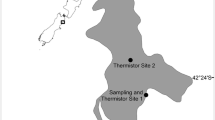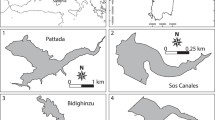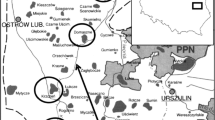Abstract
The occurrence of cyanobacteria and microcystin is highly dynamic in natural environments and poses one of the biggest challenges to water resource management. While a number of drivers are known to be responsible for the occurrence of cyanobacterial blooms, the drivers of microcystin production are not adequately known. This study aims to quantify the effects of the changes in the structures of phytoplankton and cyanobacterial communities on the dynamics of microcystin production under highly variable nutrient concentration. In our study, nutrient variability could explain 64 % of the variability in microcystin production. When changes in the fractions of non-cyanobacteria versus cyanobacteria genera were additionally included, 80 % of the variability in microcystin production could be explained; under high nutrient concentrations, non-cyanobacterial phytoplankton groups were dominant over cyanobacteria and cyanobacteria produced more toxins. In contrast, changes in the cyanobacterial community structures could only explain a further 4 % of the dynamics of microcystin production. As such, the dominance of non-cyanobacterial groups appears to be a useful factor to explain microcystin occurrence in addition to traditionally used factors such as absolute cyanobacterial cell numbers, especially when the nutrient regime is taken into account. This information could help to further refine the risk assessment frameworks which are currently used to manage the risk posed by cyanobacterial blooms.








Similar content being viewed by others
References
Albay, M., Matthiensen, A., & Codd, G. A. (2005). Occurrence of toxic blue-green algae in the Kucukcekmece Lagoon (Istanbul, Turkey). Environmental Toxicology, 20, 277–284.
APHA (1998). Standard methods for the examination of water and wastewater 20th edn.
Arnold, J. (1990). Perth Wetlands Resource Book. Perth: Environmental Protection Authority.
Arnold, T. N., & Oldham, C. E. (1997). Trace-element contamination of a shallow wetland in Western Australia. Marine and Freshwater Research, 48, 531–539.
Babica, P., Blaha, L., & Marsalek, B. (2006). Exploring the natural role of microcystins—a review of effects on photoautotrophic organisms. Journal of Phycology, 42, 9–20.
Baldia, S., Evangelista, A., Aralar, E., & Santiago, A. (2007). Nitrogen and phosphorus utilization in the cyanobacterium Microcystis aeruginosa isolated from Laguna de Bay, Philippines. Journal of Applied Phycology, 19, 607–613.
Berry, J. P., Gantar, M., Perez, M. H., Berry, G., & Noriega, F. G. (2008). Cyanobacterial toxins as allelochemicals with potential applications as algaecides, herbicides and insecticides. Marine Drugs, 6, 117–146.
Beutler, M., Wiltshire, K. H., Meyer, B., Moldaenke, C., Luring, C., Meyerhofer, M., Hansen, U. P., & Dau, H. (2002). A fluorometric method for the differentiation of algal populations in vivo and in situ. Photosynthesis Research, 72, 39–53.
Beversdorf, L. J. (2013). Spatial and temporal variation in cyanobacterial population dynamics and microcystin production in eutrophic lakes. Ph.D., The University of Wisconsin - Madison, Ann Arbor, USA.
Bittencourt-Oliveira, M.d., Chia, M., de Oliveira, H., Cordeiro Araújo, M., Molica, R. & Dias, C. (2014). Allelopathic interactions between microcystin-producing and non-microcystin-producing cyanobacteria and green microalgae: implications for microcystins production. Journal of Applied Phycology, 1–10.
Camacho, F.A. (2008). Algal chemical ecology. In C.D. Amsler (Ed.), (pp. 105–120) Heidelberg.
Chorus, I., & Bartram, J. (1999). Toxic cyanobacteria in water: a guide to their public health consequences, monitoring and management. London: E & FN Spon.
Churro, C., Dias, E., & Valério, E. (2012). In Y. Lou (Ed.), Novel approaches and their applications in risk assessment. Shanghai: InTech.
Coops, H., Beklioglu, M., & Crisman, T. (2003). The role of water-level fluctuations in shallow lake ecosystems – workshop conclusions. Hydrobiologia, 506–509, 23–27.
Dadheech, P., Selmeczy, G., Vasas, G., Padisák, J., Arp, W., Tapolczai, K., Casper, P., & Krienitz, L. (2014). Presence of potential toxin-producing cyanobacteria in an oligo-mesotrophic lake in Baltic Lake District, Germany: an ecological, genetic and toxicological survey. Toxins, 6, 2912–2931.
Dai, G., Deblois, C. P., Liu, S., Juneau, P., & Qiu, B. (2008). Differential sensitivity of five cyanobacterial strains to ammonium toxicity and its inhibitory mechanism on the photosynthesis of rice-field cyanobacterium Ge-Xian-Mi (Nostoc). Aquatic Toxicology, 89, 113–121.
Davis, J.A., Rosich, R.S., Bradley, J.S., Growns, J.E., Schmidt, L.G. & Cheal, F. (1993). Wetland classification on the basis of water quality and invertebrate community data.
Engström-Öst, J., Repka, S., & Mikkonen, M. (2011). Interactions between plankton and cyanobacterium Anabaena with focus on salinity, growth and toxin production. Harmful Algae, 10, 530–535.
Ghadouani, A., & Smith, R. E. H. (2005). Phytoplankton distribution in Lake Erie as assessed by a new in situ spectrofluorometric technique. Journal of Great Lakes Research, 31, 154–167.
Graneli, E., & Hansen, P. J. (2006). In E. Granéli & J. Turner (Eds.), Ecology of harmful algae (pp. 189–201). Heidelberg: Springer Berlin.
Graneli, E., Weberg, M., & Salomon, P. S. (2008). Harmful algal blooms of allelopathic microalgal species: The role of eutrophication. Harmful Algae, 8, 94–102.
Hillebrand, H., Durselen, C., Kirschtel, D., Pollingher, U., & Zohary, T. (1999). Biovolume calculation for pelagic and benthic microalgae. Journal of Phycology, 35, 403–424.
Holland, A., & Kinnear, S. (2013). Interpreting the possible ecological role(s) of cyanotoxins: compounds for competitive advantage and/or physiological aide? Marine Drugs, 11, 2239–2258.
Huisman, J., & Hulot, F. D. (2005). In J. Huisman, H. C. P. Matthijs, & P. M. Visser (Eds.), Harmful cyanobacteria (pp. 143–176). Netherlands: Springer.
Huisman, J., Matthijs, H. C. P., Visser, P., Edwin, W., Kardinaal, A., & Visser, P. (2005). In J. Huisman, H. C. P. Matthijs, & P. M. Visser (Eds.), Harmful cyanobacteria (pp. 41–63). Netherlands: Springer.
ISO. (2005). Determination of microcystins: method using solid phase extraction (SPE) and high performance liquid chromatography (HPLC) with ultraviolet (UV) detection.
Istvánovics, V., Somlyódy, L., & Clement, A. (2002). Cyanobacteria-mediated internal eutrophication in shallow Lake Balaton after load reduction. Water Research, 36, 3314–3322.
Jang, M. H., Ha, K., Jung, J. M., Lee, Y. J., & Takamura, N. (2006). Increased microcystin production of Microcystis aeruginosa by indirect exposure of nontoxic cyanobacteria: potential role in the development of Microcystis bloom. Bulletin of Environmental Contamination and Toxicology, 76, 957–962.
Janse, I., Kardinaal, W. E. A., Kamst-van Agterveld, M., Meima, M., Visser, P. M., & Zwart, G. (2005). Contrasting microcystin production and cyanobacterial population dynamics in two Planktothrix-dominated freshwater lakes. Environmental Microbiology, 7, 1514–1524.
Jensen, J. P., Jeppesen, E., Olrik, K., & Kristensen, P. (1994). Impact of nutrients and physical factors on the shift from cyanobacterial to chlorophyte dominance in shallow Danish lakes. Canadian Journal of Fisheries and Aquatic Sciences, 51, 1692–1699.
Jeppesen, E., Brucet, S., Naselli-Flores, L., Papastergiadou, E., Stefanidis, K., Nõges, T., Nõges, P., Attayde, J., Zohary, T., Coppens, J., Bucak, T., Menezes, R., Freitas, F., Kernan, M., Søndergaard, M., & Beklioğlu, M. (2015). Ecological impacts of global warming and water abstraction on lakes and reservoirs due to changes in water level and related changes in salinity. Hydrobiologia, 750, 201–227.
Jiang, Y., Ji, B., Wong, R. N. S., & Wong, M. H. (2008). Statistical study on the effects of environmental factors on the growth and microcystins production of bloom-forming cyanobacterium Microcystis aeruginosa. Harmful Algae, 7, 127–136.
Joung, S.-H., Oh, H.-M., Ko, S.-R., & Ahn, C.-Y. (2011). Correlations between environmental factors and toxic and non-toxic Microcystis dynamics during bloom in Daechung Reservoir, Korea. Harmful Algae, 10, 188–193.
Kardinaal, W. E. A., Janse, I., Kamst-van Agterveld, M., Meima, M., Snoek, J., Mur, L. R., Huisman, J., Zwart, G., & Visser, P. M. (2007). Microcystis genotype succession in relation to microcystin concentrations in freshwater lakes. Aquatic Microbial Ecology, 48, 1–12.
Kearns, K. D., & Hunter, M. D. (2000). Green algal extracellular products regulate antialgal toxin production in a cyanobacterium. Environmental Microbiology, 2, 291–297.
Lawton, L. A., Edwards, C., & Codd, G. A. (1994). Extraction and high-performance liquid chromatographic method for the determination of microcystins in raw and treated waters. Analyst, 119, 1525–1530.
Legendre, P., & Legendre, L. (1998). Numerical ecology. Amsterdam: Elsevier.
Li, Y., & Li, D. (2011). Competition between toxic Microcystis aeruginosa and non-toxic Microcystis Wesenbergii with Anabaena PCC7120. Journal of Applied Phycology, 24, 69–78.
Macías, F., Galindo, J., García-Díaz, M., & Galindo, J. (2008). Allelopathic agents from aquatic ecosystems: potential biopesticides models. Phytochemistry Reviews, 7, 155–178.
Millie, D. F., Fahnenstiel, G. L., Bressie, J. D., Pigg, R. J., Rediske, R. R., Klarer, D. M., Tester, P. A., & Litaker, R. W. (2009). Late-summer phytoplankton in western Lake Erie (Laurentian Great Lakes): Bloom distributions, toxicity, and environmental influences. Aquatic Ecology, 43, 915–934.
Nagai, T., Imai, A., Matsushige, K., & Fukushima, T. (2007). Growth characteristics and growth modeling of Microcystis aeruginosa and Planktothrix agardhii under iron limitation. Limnology, 8, 261–270.
O’Neil, J. M., Davis, T. W., Burford, M. A., & Gobler, C. J. (2012). The rise of harmful cyanobacteria blooms: the potential roles of eutrophication and climate change. Harmful Algae, 14, 313–334.
Orihel, D. M., Bird, D. F., Brylinsky, M., Chen, H. R., Donald, D. B., Huang, D. Y., Giani, A., Kinniburgh, D., Kling, H., Kotak, B. G., Leavitt, P. R., Nielsen, C. C., Reedyk, S., Rooney, R. C., Watson, S. B., Zurawell, R. W., & Vinebrooke, R. D. (2012). High microcystin concentrations occur only at low nitrogen-to-phosphorus ratios in nutrient-rich Canadian lakes. Canadian Journal of Fisheries and Aquatic Sciences, 69, 1457–1462.
Paerl, H. W., & Otten, T. G. (2013). Harmful cyanobacterial blooms: causes, consequences, and controls. Microbial Ecology, 65, 995–1010.
Pflugmacher, S. (2002). Possible allelopathic effects of cyanotoxins, with reference to microcystin-LR, in aquatic ecosystems. Environmental Toxicology, 17, 407–413.
Pinheiro, C., Azevedo, J., Campos, A., Loureiro, S., & Vasconcelos, V. (2013). Absence of negative allelopathic effects of cylindrospermopsin and microcystin-LR on selected marine and freshwater phytoplankton species. Hydrobiologia, 705, 27–42.
Reichwaldt, E. S., Song, H., & Ghadouani, A. (2013). Effects of the distribution of a toxic Microcystis bloom on the small scale patchiness of zooplankton. Plos One, 8, e66674.
Reynolds, C. S. (1998). What factors influence the species composition of phytoplankton in lakes of different trophic status? Hydrobiologia, 369–370, 11–26.
Reynolds, C.S., Usher, M., Saunders, D., Dobson, A., Peet, R., Adam, P., Birks, H.J.B., Gustafssor, L., McNelly, J., Paine, R.T. & Richardson, D. (2006). The ecology of phytoplankton, (pp. 178–238). Cambridge University Press.
Rinta-Kanto, J. M., Konopko, E. A., DeBruyn, J. M., Bourbonniere, R. A., Boyer, G. L., & Wilhelm, S. W. (2009). Lake Erie Microcystis: relationship between microcystin production, dynamics of genotypes and environmental parameters in a large lake. Harmful Algae, 8, 665–673.
Rzymski, P., Poniedziałek, B., Kokociński, M., Jurczak, T., Lipski, D., & Wiktorowicz, K. (2014). Interspecific allelopathy in cyanobacteria: Cylindrospermopsin and Cylindrospermopsis raciborskii effect on the growth and metabolism of Microcystis aeruginosa. Harmful Algae, 35, 1–8.
Scott, L. L., Downing, S., Phelan, R. R., & Downing, T. G. (2014). Environmental modulation of microcystin and β-N-methylamino-l-alanine as a function of nitrogen availability. Toxicon, 87, 1–5.
Sinang, S., Reichwaldt, E., & Ghadouani, A. (2013). Spatial and temporal variability in the relationship between cyanobacterial biomass and microcystins. Environmental Monitoring and Assessment, 185, 6379–6395.
Soares, M. C. S., Rocha, M. I. A., Marinho, M. M., Azevedo, S. M. F. O., Branco, C. W. C., & Huszar, V. L. M. (2009). Changes in species composition during annual cyanobacterial dominance in a tropical reservoir: physical factors, nutrients and grazing effects. Aquatic Microbial Ecology, 57, 137–149.
Švercel, M. (2013). Cyanobacteria: ecology, toxicology and management. In S. Aloysio Da Ferrão-Filho (Ed.), (pp. 27–41), Nova Science Publishers, United States of America.
Utermöhl, H. (1958). Zur vervollkommnung der quantitativen phytoplankton-methodik. Mitteilungen Internationale Vereinigung fur Theoretische und Angewandte Limnologie, 9, 1–38.
Utkilen, H., & Gjolme, N. (1995). Iron-stimulated toxin production in Microcystis aeruginosa. Applied and Environmental Microbiology, 61, 797–800.
Van de Waal, D. B., Verspagen, J. M. H., Lürling, M., Van Donk, E., Visser, P. M., & Huisman, J. (2009). The ecological stoichiometry of toxins produced by harmful cyanobacteria: an experimental test of the carbon-nutrient balance hypothesis. Ecology Letters, 12, 1326–1335.
Vezie, C., Rapala, J., Vaitomaa, J., Seitsonen, J., & Sivonen, K. (2002). Effect of nitrogen and phosphorus on growth of toxic and nontoxic Microcystis strains and on intracellular microcystin concentrations. Microbial Ecology, 43, 443–454.
Woodward, B. (2008). Literature and Interview Project: Constructed Lakes in the Perth Metropolitan and South West Region. Prepared for Department of Water, Western Australian Local Government Association.
Wu, Y., Li, L., Gan, N., Zheng, L., Ma, H., Shan, K., Liu, J., Xiao, B., & Song, L. (2014). Seasonal dynamics of water bloom-forming Microcystis morphospecies and the associated extracellular microcystin concentrations in large, shallow, eutrophic Dianchi Lake. Journal of Environmental Sciences, 26, 1921–1929.
Yang, J., Deng, X., Xian, Q., Qian, X., & Li, A. (2014). Allelopathic effect of Microcystis aeruginosa on Microcystis wesenbergii: microcystin-LR as a potential allelochemical. Hydrobiologia, 727, 65–73.
Zurawell, R. W., Chen, H. R., Burke, J. M., & Prepas, E. E. (2005). Hepatotoxic cyanobacteria: a review of the biological importance of microcystins in freshwater environments. Journal of Toxicology and Environmental Health-Part B-Critical Reviews, 8, 1–37.
Acknowledgments
This project was funded by the Australian Research Council’s Linkage Project funding scheme (LP0776571) and the Water Corporation of Western Australia. We wish to thank the City of Cockburn and the City of Stirling for permission to sample the lakes, Professor Pierre Legendre, Laura Firth, and Kevin Murray for their valuable statistical advice, and Liah Coggins for her help in the editing of the manuscript. During the study, Sinang, S.C was supported by a scholarship from Universiti Pendidikan Sultan Idris (UPSI) and the Malaysian Government.
Author information
Authors and Affiliations
Corresponding author
Rights and permissions
About this article
Cite this article
Sinang, S.C., Reichwaldt, E.S. & Ghadouani, A. Could the presence of larger fractions of non-cyanobacterial species be used as a predictor of microcystin production under variable nutrient regimes?. Environ Monit Assess 187, 476 (2015). https://doi.org/10.1007/s10661-015-4695-z
Received:
Accepted:
Published:
DOI: https://doi.org/10.1007/s10661-015-4695-z




